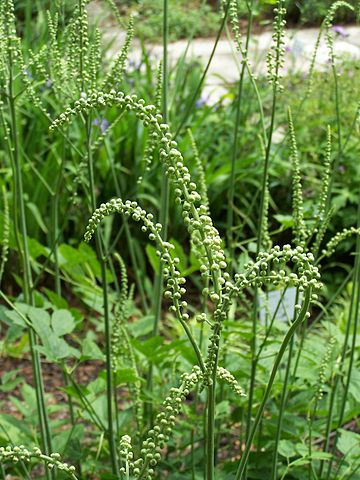When you hear of the herb black cohosh, what do you think it treats? Today most people say, “Menopause,” as it has been shown to stop hot flashes. However, this herb does far more than that and is a prime example of a plant that’s been limited by commercialization. Chinese medicine also uses black cohosh; although it uses a different species, there are still many similarities. Overall, this herb is an excellent example of how we can combine Western tradition, Chinese medicine, and modern research to widen an herb’s usage.
Black cohosh, Cimicifuga racemosa, Actaea racemosa (Western), C. foetida (sheng ma, Chinese), is in the Ranunculaceae family and the rhizome is used. It has a cool energy, has acrid, slightly sweet, and slightly bitter flavors, and enters the Liver, Spleen, Stomach, Large Intestine, and Uterus. C. racemosa is antispasmodic, expectorant, emmenagogue, alterative, parturient, nervine, uterine tonic, diaphoretic and antirheumatic, while C. foetida is diaphoretic, expectorant, antispasmodic, emmenagogue, alterative, parturient, uterine tonic, and antirheumatic.
Also known as black snakeroot and rattlesnake root, (referring to its past use in North America to treat snakebites, including rattlesnake), and as bugbane (cimicifuga means “to chase insects away” in Latin and so was used as an insect repellant), this herb is currently under heavy demand for its treatment of many menopausal complaints and so is now endangered. Thus, only use the cultivated plant. Although black cohosh has been used for centuries in the West, it hit the popular market after German tests showed its benefit in the treatment of menopausal and ovarian insufficiency symptoms. Some studies also claim it to be a phyto-estrogen, meaning it has estrogenic-like compounds that bind to estrogen receptor sites, causing the body to act as if it has been given estrogen. However, it only seems to do this, if at all, for the brain, bones, and nervous system, not the uterus, since other studies don’t show it to have any estrogenic activity at all. Regardless, phyto-hormonal herbs don’t contain hormones anyway but may mimic their functions by latching onto a cell’s hormonal receptor sites resulting in the same benefits of estrogen to the body.
Still, black cohosh does alleviate menopausal symptoms of hot flashes, night sweats, tachycardia, insomnia, mood swings, fatigue, dry vagina, PMS with breast pain, and dysmenorrhea in those with heat. Further, it works for women of all ages to treat menstrual irregularity, PMS, headaches right before the period (due to low-estrogen levels), menstrual cramps and spasms, excessive menstrual bleeding, delayed and painful menses, ovarian pain, endometriosis, and late menstruation. As well, it tones the uterine muscles and counters prolapse of the uterus. It also helps with the hormonal decline after hysterectomies or ovariectomies, but needs to be taken for two to six months for results. Black cohosh is a luteinizing hormone (LH) inhibitor. LH normally releases eggs at mid-cycle. When it’s high, it indicates either low hormone production, non-ovulation, or else menopause has set in.
Black cohosh can lower LH and FSH/LH levels without changing FSH (follicle-stimulating hormone) levels. This means it can stimulate ovulation induction and enhance fertility, especially in those with polycystic ovarian syndrome (PCOS).[1] In terms of menopause, I’ve seen black cohosh work wonders for those with heat in the Liver. However, it doesn’t work well for those with menopausal symptoms due to Blood Deficiency or Yin Deficiency, which could be one reason there are still conflicting studies regarding its efficacy for menopause. [Signs of blood deficiency include dizziness, blurry vision, numbness, restlessness, anxiety, slight irritability, insomnia, scanty menses or amenorrhea, thinness or emaciation, dark spots in the visual field, dry skin, hair or eyes, lusterless, pale face and lips, tiredness, easily startled or overwhelmed, and poor memory. Signs of Yin Deficiency include night sweats, malar flush (redness and burning heat along the cheeks and nose), burning sensation in the palms of the hands, soles of the feet and in the chest, afternoon fever or feelings of heat, restless sleep, dry throat or thirst at night, agitation, mental restlessness, dry cough, dry stools, and scanty dark urine.
But there’s more. Black cohosh has been shown to inhibit osteoclastogenesis when bone resorption exceeds bone formation, and so is useful for osteoporosis, too.[2] And yet, it appears to help menopausal symptoms and osteoporosis without increasing any long-term risks of breast or endometrial cancer. In fact, not only has it been shown to not affect mammary gland density but also it has a significant breast cancer protective effect.[3] There are also studies that show it has a significant decrease on the growth of breast cancer cells.
In the next installment we will take a look at the traditional uses of black cohosh around the world.
Image above: “Cimicifuga racemosa 001”. Licensed under CC BY-SA 3.0 via Wikimedia Commons – http://commons.wikimedia.org/wiki/File:Cimicifuga_racemosa_001.jpg#/media/File:Cimicifuga_racemosa_001.jpg


Thank you for this amazing and comprehensive article on Black Cohosh. I am currently studying TCM and I have been curious about this discrepancy for awhile. We have been taught that menopause is a form of Yin Deficiency – the idea being that the only reason there are heat signs are because there is insufficient Yin/fluids [due to declining Kidney Essence from natural aging] to anchor the yang which manifests as heat. So to strongly clear the heat would not address the root issue but rather just the symptoms. However, according to your article there is actually a form of menopause that is not a form of Yin Deficiency. I am curious how you would describe the pattern of someone experiencing purely excess heat in menopause? I’m trying to understand the differentiation between the two and what specific signs/symptoms you would use to go ahead and prescribe sheng ma. Thank you for all that you do – your articles are so valuable to synthesize the ancient and modern approaches to medicine to create a whole not yet truly appreciated (but growing exponentially everyday).